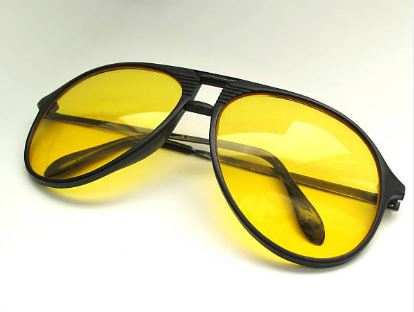Eyeglasses can be made with lenticular lenses, a specific kind of lens. Even though they’re not frequently used, they can be very helpful when you do. These lenses treat extreme farsightedness. You can’t see things clearly up close because of this.
A lenticular lens that corrects extreme nearsightedness is also a possibility. Learn more about lenticular lenses, including their uses outside of vision correction, as you continue reading.
Table of Contents
What Are Lenticular Lenses for Glasses?
When implants cannot be used, lenticulars are typically used in eyeglasses to treat extreme farsightedness. An operation to remove a cataract could have caused farsightedness. To compensate for extreme nearsightedness, on the other hand, a “minus lenticular” lens is also used. The power of the lens is typically concentrated in a small area at its center.
The production of much heavier and thicker lenses would theoretically result from manufacturers dispersing the power throughout the lens. When using lenticular lenses, the power of the remainder of the lens will be minimal to nonexistent. They will only support the lenticular portion of the lens.
The majority of the time, lenticular lenses have two distinct magnifications. Refractive correction is available in one area of the lens. Another distinct power is also present in the other area. The design of the glasses causes the pupil of a farsighted person to appear larger than usual. For nearsightedness, it will be smaller than anticipated.
What Are Lenticular Lenses Used For?
Multiple conditions can be treated with lenticular lenses. This includes:
- An individual with aphakia does not have an internal lens in their eye. Vision blurring and difficulty focusing, especially up close, are both symptoms of aphakia. It is possible to treat aphakia with lenticular eyeglass lenses. When the condition affects both eyes, they work best.
- High myopia (severe nearsightedness), when you need glasses with a very strong prescription to help you see objects in the distance. High myopia is a degree of nearsightedness with a refractive measurement of more than or equal to 6.00 diopters. (Between 0.25 and 3.00 diopters is considered to be mild nearsightedness.)
- If you have severe hyperopia (farsightedness), you will require a very strong prescription for glasses or contact lenses because you can see objects in the distance more clearly than those that are close to you.
What Are the Types of Lenticular Lenses?
There are three types of lenticular lenses, which include the following:
1. High-plus. These lenticular lenses have a higher power in the center of the lens than on the outside. Typically, they come with a trifocal lens that has a 10 to 15-diopter center. The area becomes quite thick as a result. The remainder of the lens, meanwhile, is sufficiently thin to fit inside the eyeglass’s frame. Nearsighted people with poor vision frequently wear high-plus lenticular lenses.
2. High-negative. The opposite of high-plus lenticular lenses is this. Low-positive lenses have a center with lower power and sides with a higher power. As a result, the lenses at the center appear thinner while appearing much thicker on the outside. People who have trouble focusing on distant objects frequently use high-negative lenticular lenses. They, therefore, require a minus-10 diopter correction at the very least. The result is that when wearing high-negative lenticular lenses, the pupil appears smaller than usual.
3. Bifocals. These lenses are intended for those who struggle to see near- and far-off objects. To see distant objects, use the upper part of the lens. The bottom of the lens, meanwhile, facilitates viewing objects up close.

What Are the Pros and Cons of Lenticular Lenses?
Lenticular lenses are going to be helpful for people with cataracts. An ophthalmologist can implant a new lens if the eye’s natural lens becomes cloudy and causes vision blur. It won’t always be possible to implant lenses, though. They advise using lenticular lenses as a result.
Although wearing lenticular lenses might take some getting used to, they can be helpful. The disadvantage is that those who wear contact lenses must learn how to focus on specific areas of the lens in order to improve their vision. In addition, they must be aware of where to look when viewing nearby or faraway objects. These lenses can be quite expensive as the majority must be meticulously made to order. The lenses can result in blurry vision if the measurements are off even a small amount (a few millimeters).
Are Lenticular Lenses Right for You?
Consult your eye doctor if you begin to notice alterations in your vision.
Contact your eye doctor if you’re:
- having trouble with night vision
- noticing a sudden blurriness in your vision
- seeing double
- seeing numbers or letters less sharply
- finding that you’re tripping or are less steady on your feet due to depth perception changes
Your eye doctor will take note of your symptoms and perform tests to find any potential underlying causes.
Your doctor may perform tests to detect cataracts, such as slit-lamp examinations or retinal exams conducted by dilating the pupils.
If your doctor prescribes lenticular lenses, they will explain how to wear them correctly and how the lenses are fitted to your eyes.
Who Needs Lenticular Lenses?
Most people need multi-focal lenses (i.e. bifocal, trifocal, and progressive lenses) when there is more than one vision problem to correct. Lenticular lenses are occasionally necessary for the treatment of serious eye conditions like cataracts.
How Much Do Lenticular Lenses Cost?
Consumer Reports estimates that the price of a typical bifocal lens is around $105. The price of those designed to treat cataracts or other visual issues may be higher.
Cost factors for lenticular lenses
- how they’re manufactured
- what you need them for (reading, everyday use, etc.)
- whether your vision insurance covers these lenses
Lenticular Lenses Vs. Progressive Lenses
There are differences between lenticular and progressive lenses when compared closely.
The structure of each is different, first. In a progressive lens, near vision is prescribed at the bottom, intermediate vision in the middle, and distance vision at the top. Lenticular lenses, on the other hand, have a round focal point in the middle of each lens, surrounded by weaker or nonexistent lenses.
Second, progressive lenses do not have lines distinguishing the various vision powers. For lenticular lenses, though, this is not true.
Third, some users of lenticular lenses report feeling lightheaded, having headaches, and having tired eyes. Progressives may also cause a hazy field of vision when moving.
Lenticular lenses are more affordable than progressive lenses, which is more important. This may still change, though, based on the manufacturer, prescriptions, and lens requirements.
Conclusion
Lenticular lenses have advantages in general, especially for those who really need them. When purchasing these lenses, it is wise to take into account a variety of factors, including your eye health, price, benefits and drawbacks, and potential side effects. You can then set reasonable goals in this manner. Lenticular lenses still cost money, despite the fact that they are less expensive. You need to get what you pay for on your end as well.


